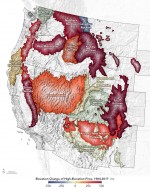
Thursday, October 14th, 2021
NASA released a climate action plan Oct. 7, 2021, aimed at averting mission impacts due to climate change, ensuring the resiliency of facilities and assets, and providing the nation and world unique climate observations, analysis, and modeling through scientific research. The plan is part of President Biden’s whole-of-government approach to confronting the climate crisis. Federal

Tuesday, October 5th, 2021
If it seems like enormous wildfires have been constantly raging in California in recent summers, it’s because they have. Eight of the state’s 10 largest fires on record—and 12 of the top 20—have happened within the last five years, according to the California Department of Forestry and Fire Protection (Cal Fire). Together, those 12 fires

Tuesday, September 21st, 2021
Self-driving vehicles such as cars, ships and drones offer the potential for reduced costs, lower environmental impacts and fewer accidents. Now, a new open dataset from researchers at Chalmers University of Technology, Sweden, sets a new standard for evaluating the algorithms of such vehicles, and the development of autonomous transport systems on roads, water and

Tuesday, September 7th, 2021
Scientists have known for decades that climate change makes wildfires more common, larger and more intense. Now an international team of scientists has demonstrated a new connection between fires and global warming. Using data from Landsat satellites, they discovered that wildfires in the western United States have been spreading to higher elevations due to warmer

Wednesday, August 25th, 2021
As soil and other surfaces dry, water is transferred into the air as water vapor (i.e., evaporation). Plants actively release water, moving it out of their leaves and stems and into the drier air (i.e., transpiration). The two combine for evapotranspiration: the process through which water leaves plants, soils and other surfaces. It’s a measurement

Tuesday, August 10th, 2021
Scientists are observing changes in the Earth’s climate in every region and across the whole climate system, according to the latest Intergovernmental Panel on Climate Change (IPCC) Report released Aug. 9, 2021. Many of the changes observed in the climate are unprecedented in thousands, if not hundreds of thousands of years, and some of the

Tuesday, July 27th, 2021
Earth’s trees and plants pull vast amounts of carbon dioxide out of the atmosphere during photosynthesis, incorporating some of that carbon into structures such as wood. Areas that absorb more carbon than they emit are called carbon sinks. But plants can also emit the greenhouse gas during processes like respiration, when dead plants decay or

Tuesday, July 13th, 2021
In the mid-2030s, every U.S. coast will experience rapidly increasing high-tide floods, when a lunar cycle will amplify rising sea levels caused by climate change. High-tide floods—also called nuisance floods or sunny-day floods—are already a familiar problem in many cities on the U.S. Atlantic and Gulf coasts. The National Oceanic and Atmospheric Administration (NOAA)

Tuesday, June 29th, 2021
Extraordinary heat events occur around the planet during most summers, but the current heatwave in the Pacific Northwest is truly exceptional. In June 2021, all-time temperature records fell in multiple cities in the U.S. and Canada during a heatwave that the National Weather Service called “historic and dangerous.” The heat is apparent in this map

Thursday, June 10th, 2021
Frequently in the news, Earth’s declining ice is without doubt one of the biggest casualties of climate change. However, calculating the amount of ice we are losing can be a challenge. While monitoring the area of land and ocean covered by ice is relatively straightforward using images from satellites carrying camera-like instruments, scientists need to
